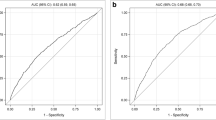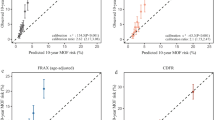Abstract
Summary
We followed 2,266 postmenopausal Chinese women for 4.5 years to determine which model best predicts osteoporotic fracture. A model that contains ethnic-specific risk factors, some of which reflect frailty, performed as well as or better than the well-established FRAX model.
Introduction
Clinical risk assessment, with or without T-score, can predict fractures in Chinese postmenopausal women although it is unknown which combination of clinical risk factors is most effective. This prospective study sought to compare the accuracy for fracture prediction using various models including FRAX, our ethnic-specific clinical risk factors (CRF) and other simple models.
Methods
This study is part of the Hong Kong Osteoporosis Study. A total of 2,266 treatment naïve postmenopausal women underwent clinical risk factor and bone mineral density assessment. Subjects were followed up for outcome of major osteoporotic fracture and receiver operating characteristic (ROC) curves for different models were compared. The percentage of subjects in different quartiles of risk according to various models who actually fractured was also compared.
Results
The mean age at baseline was 62.1 ± 8.5 years and mean follow-up time was 4.5 ± 2.8 years. A total of 106 new major osteoporotic fractures were reported, of which 21 were hip fractures. Ethnic-specific CRF with T-score performed better than FRAX with T-score (based on both Chinese normative and National Health and Nutrition Examination Survey (NHANES) databases) in terms of AUC comparison for prediction of major osteoporotic fracture. The two models were similar in hip fracture prediction. The ethnic-specific CRF model had a 10% higher sensitivity than FRAX at a specificity of 0.8 or above.
Conclusion
CRF related to frailty and differences in lifestyle between populations are likely to be important in fracture prediction. Further work is required to determine which and how CRF can be applied to develop a fracture prediction model in our population.


Similar content being viewed by others
References
Ioannidis G, Papaioannou A, Hopman WM, Noori A-D, Tassos A, Pickard L, Kennedy CC, Prior JC, Olszynski WP, Davison KS, Goltzman D, Thabane L, Amiran G, Papadimitropoulos E, Brown J, Josse R, Hanley D, Adachi JD (2009) Relation between fractures and mortality: results from the Canadian Multicentre Osteoporosis Study. CMAJ1 81:265–270
Johnell O, Kanis JA (2006) An estimate of the worldwide prevalence and disability associated with osteoporotic fractures. Osteoporos Int 17:1726–1733
Schuit SC, van der Klift M, Weel AE, de Laet CE, Burger H, Seeman E, Hofman A, Uitterlinden AG, van Leeuwen JP, Pols HA (2004) Fracture incidence and association with bone mineral density in elderly men and women: the Rotterdam Study. Bone 34:195–202
Stone KL, Seeley DG, Lui LY, Cauley JA, Ensrud K, Browner WS, Nevitt MC, Cummings SR, Osteoporotic Fractures Research Group (2003) BMD at multiple sites and risk of fracture of multiple types: long-term results from the Study of Osteoporotic Fractures. J Bone Miner Res 18:1947–1954
Wainwright SA, Marshall LM, Ensrud KE, Cauley JA, Black DM, Hillier TA, Hochberg MC, Vogt MT, Orwoll ES, Study of Osteoporotic Fractures Research Group Study of Osteoporotic Fractures Research Group (2005) Hip fracture in women without osteoporosis. J Clin Endocrinol Metab 90:2787–2793
Kanis JA, Johnell O, Oden A, De Laet C, Jonsson B, Dawson A (2002) Ten-year risk of osteoporotic fracture and the effect of risk factors on screening strategies. Bone 30:251–258
Nguyen ND, Frost SA, Center JR, Eisman JA, Nguyen TV (2007) Development of a nomogram for individualizing hip fracture risk in men and women. Osteoporos Int 18:1109–1117
Trémollieres FA, Pouillès JM, Drewniak N, Laparra J, Ribot CA, Dargent-Molina P (2010) Fracture risk prediction using BMD and clinical risk factors in early postmenopausal women: sensitivity of the WHO FRAX tool. J Bone Miner Res May 25(5):1002–1009
Cooper C, Melton LJ (1992) Hip fractures in the elderly: a world-wide projection. Osteoporos Int 2:285–289
Colón-Emeric CS, Lyles KW (2009) Should there be a fracas over FRAX and other fracture prediction tools?: Comment on “A comparison of prediction models for fractures in older women”. Arch Intern Med 169(22):2094–2095
Nguyen ND, Frost SA, Center JR, Eisman JA, Nguyen TV (2008) Development of prognostic nomograms for individualizing 5-year and 10-year fracture risks. Osteoporos Int 19:1431–1444
Hippisley-Cox J, Coupland C (2009) Predicting risk of osteoporotic fracture in men and women in England and Wales: prospective derivation and validation of QFractureScores BMJ 339:b4229
van den Bergh JP, van Geel TA, Lems WF, Geusens PP (2010) Assessment of individual fracture risk: FRAX and beyond Curr Osteoporos Rep 8(3):131–137
Oden A, Johnell O, Johansson H, De Laet C, Brown J, Burckhardt P, Cooper C, Christiansen C, Cummings S, Eisman JA, Fujiwara S, Glüer C, Goltzman D, Hans D, Krieg MA, La Croix A, McCloskey E, Mellstrom D, Melton LJ 3rd, Pols H, Reeve J, Sanders K, Schott AM, Silman A, Torgerson D, van Staa T, Watts NB, Yoshimura N (2007) The use of clinical risk factors enhances the performance of BMD in the prediction of hip and osteoporotic fractures in men and women. Osteoporos Int 18(8):1033–1046
Ensrud KE, Lui LY, Taylor BC, Schousboe JT, Donaldson MG, Fink HA, Cauley JA, Hillier TA, Browner WS, Cummings SR, Study of Osteoporotic Fractures Research Group (2009) A comparison of prediction models for fractures in older women: is more better? Arch Intern Med 169(22):2087–2094
Kung AWC, Lee KK, Ho AYY, Tang G, Luk KDK (2007) Ten-year risk of osteoporotic fractures in postmenopausal Chinese women according to clinical risk factors and BMD T-scores: a prospective study. J Bone Miner Res 22(7):1080–1087
Mei J, Yeung SSC, Kung AWC (2001) High dietary phytoestrogen intake is associated with higher bone mineral density in postmenopausal but not premenopausal women. J Clin Endocrinol Metab 86:5217–5221
Kung AWC, Luk KDK, Chu LW, Tang GWK (1999) Quantitative ultrasound and symptomatic vertebral fracture risk in Chinese women. Osteoporos Int 10:456–461
Lachin JM (2000) Biostatistical methods: The assessment of relative risks. Wiley, New York
Dorfman DD, Berbaum KS, Metz CE (1992) Receiver operating characteristic rating analysis. Generalization to the population of readers and patients with the jackknife method. Invest Radiol 27(9):723–731
Donaldson MG, Palermo L, Schousboe JT, Ensrud KE, Hochberg MC, Cummings SR (2009) FRAX and risk of vertebral fractures: the fracture intervention trial. J Bone Miner Res 24(11):1793–1799
Berry SD, Ngo L, Samelson EJ, Kiel DP (2010) Competing risk of death: an important consideration in studies of older adults. J Am Geriatr Soc 58(4):783–787
Conflicts of interest
None.
Author information
Authors and Affiliations
Corresponding author
Rights and permissions
About this article
Cite this article
Cheung, E.Y.N., Bow, C.H., Cheung, C.L. et al. Discriminative value of FRAX for fracture prediction in a cohort of Chinese postmenopausal women. Osteoporos Int 23, 871–878 (2012). https://doi.org/10.1007/s00198-011-1647-5
Received:
Accepted:
Published:
Issue Date:
DOI: https://doi.org/10.1007/s00198-011-1647-5




